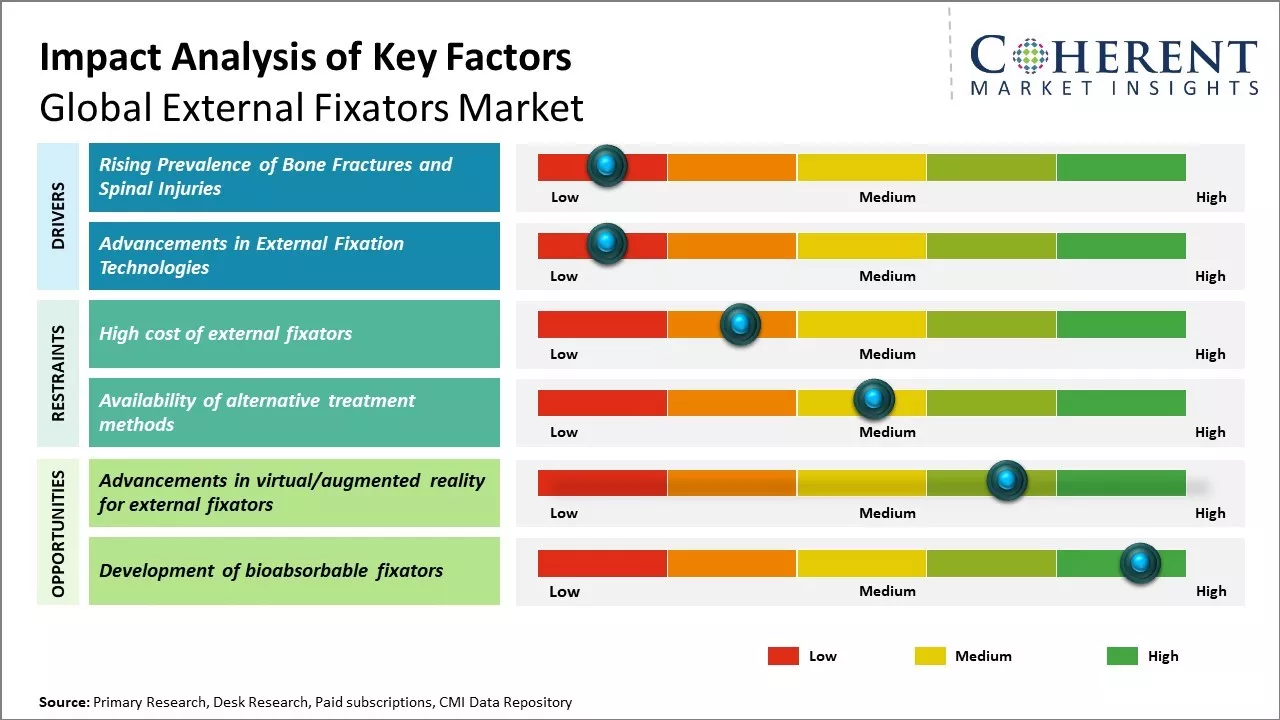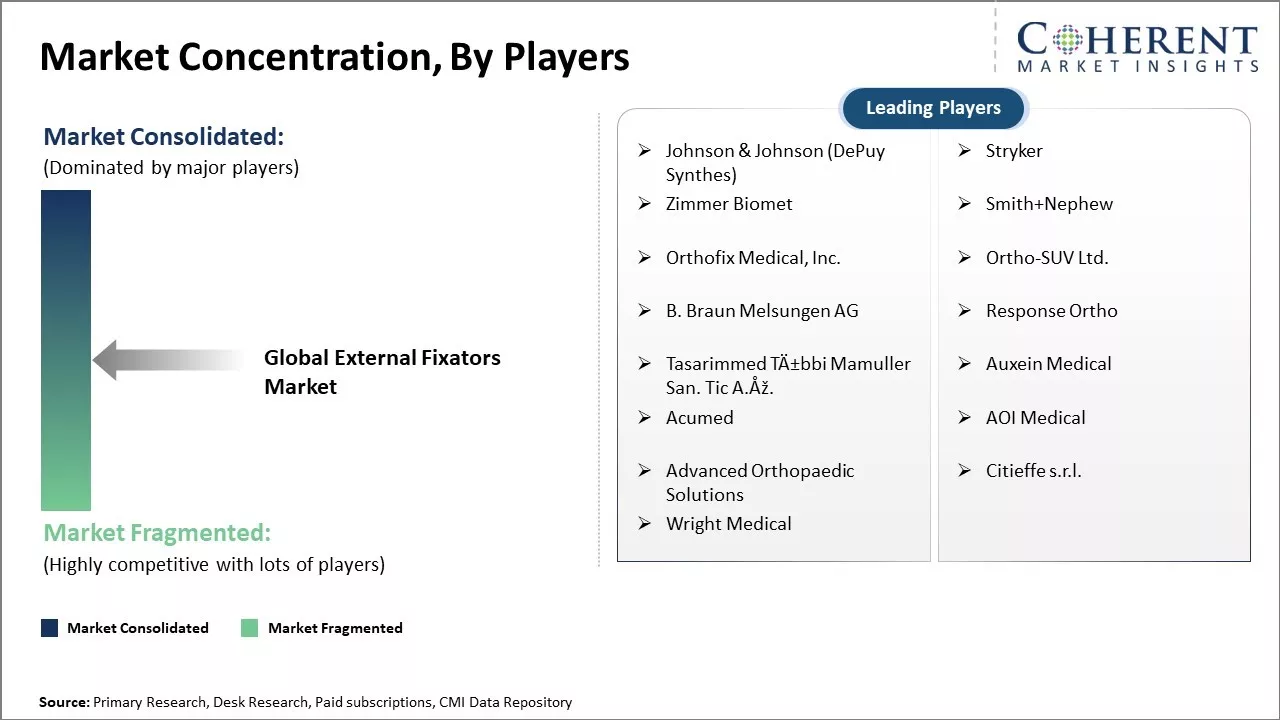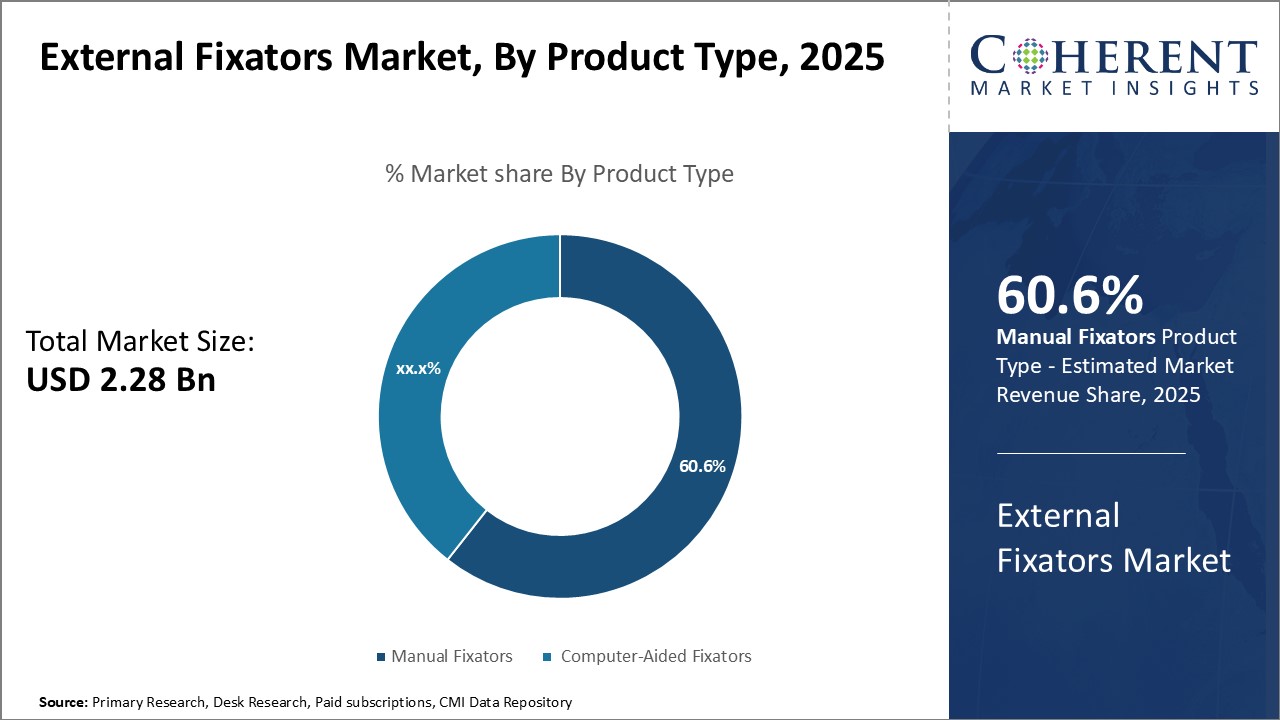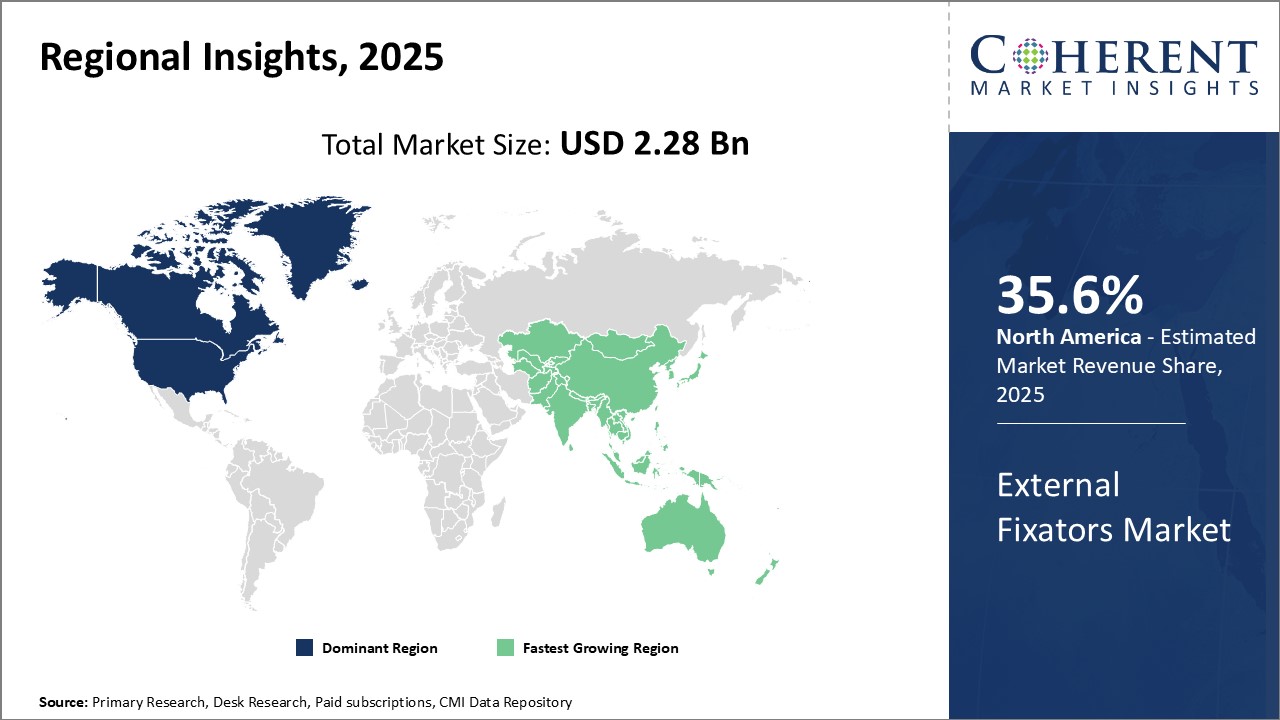The global external fixators market is estimated to be valued at USD 2.28 Bn in 2025 and is expected to reach USD 4.10 Bn by 2032, exhibiting a compound annual growth rate (CAGR) of 8.7% from 2025 to 2032.

Discover market dynamics shaping the industry: Download Free Sample
Over the forecast period of 2025-2032, the global external fixators market is expected to witness a positive growth trend. Orthopedic surgeons are increasingly adoption external fixation devices over invasive internal fixation procedures owing to their minimal invasion and faster recovery time. Furthermore, the rising number of trauma & accident cases globally due to road accidents and sports injuries has driven the demand for external fixators in emergency stabilization of bone fractures. New product launches catering to specific bone fractures and incorporating the latest technologies to improve patient outcomes are helping companies to strengthen their market position. However, high costs of external fixators and availability of alternative treatment methods are some factors that are expected to restrain the market growth to some extent over the forecast period.
Rising Prevalence of Bone Fractures and Spinal Injuries
The prevalence of bone fractures and spinal injuries has been rising globally which is one of the major factors fueling the growth of the external fixators market. According to recent data from World Health Organization (WHO), road accidents continue to rise in developing countries due to rapid motorization and urbanization leading to more than 1.3 million deaths each year, with many resulting in bone fractures and other severe injuries requiring long immobilization. Additionally, a 2021 report from Centers of Disease Control and Prevention (CDC), over 10 million people sustain osteoporosis-related fractures annually in the U.S., out of which nearly 2 million are spinal fractures mainly caused due to age-related bone weakening.
External fixators are being increasingly used by orthopedic surgeons worldwide to treat such injuries as they allow the stabilization of fractured bones without internal fixation which helps early mobilization and weight bearing. Moreover, circular external fixators are gaining more preference for treating injuries around knees, joints, and bones as they provide 360-degree stability and better mechanical strength compared to linear and hybrid fixators. For instance, in October 2021, an article titled 'The Incidence of Fractures Among the Adult Population of Germany' reported a 14% increase in the incidence of fractures, reaching 1,014 fractures per 100,000 persons annually over the past decade. The article highlighted femoral neck fractures (120 per 100,000 persons per year), per trochanteric femoral fractures (109 per 100,000 persons per year), and distal radius fractures (106 per 100,000 persons per year) as the most common types. This rising frequency of fractures, especially among older adults, is contributing to the growing demand for external fixation surgical treatments, thereby stimulating the market growth.

Get actionable strategies to beat competition: Download Free Sample
Advancements in External Fixation Technologies
The external fixators market has evolved remarkably over the past few years owing to continuous innovation and product development efforts by key industry players. Earlier fixator systems were rudimentary and had certain limitations like inadequate stability. However, modern external fixation systems have benefited greatly from new material advances and design refinements. The emergence of low-profile mono lateral and circular fixators offering enhanced stability without compromising patient mobility is proving immensely beneficial. Similarly, innovative fixator constructs allowing precise 3D adjustments and full axial stability have raised the bar for trauma care. The addition of features such as radiolucency, locking screw capabilities, and multiplanar frame designs have augmented the precision, versatility and functional outcomes associated with external fixation approach. Adoption of cannulated screws, half-pins, and advanced clamping mechanisms have elevated the construct strength substantially. Carbon fiber and polymer-based load-sharing fixator elements delivering superior biocompatibility make for the appealing adoption of drivers as well.
Key Takeaways from Analyst:
The global external fixators market is poised to grow steadily over the next decade. Rising number of road accidents and surge in trauma injuries are some of the primary drivers propelling the demand for external fixators. Additionally, the increasing prevalence of osteoporosis and bone fractures especially among the geriatric population will further contribute to the market growth. However, high costs associated with external fixators and availability of alternative treatment methods may hinder the market expansion to some extent.
North America currently dominates the external fixators market and is expected to retain its leading position throughout the forecast period. Presence of highly developed healthcare infrastructure and rising healthcare spending are major factors supporting the large share of the region. Asia Pacific is projected to emerge as the fastest growing market owing to the growing number of orthopedic surgeries and improving access to healthcare in developing countries of the region.
Key players should focus on introducing innovative product varieties to strengthen their market position. Companies are investing in R&D activities to develop technologically-advanced external fixation systems with improved functionality and comfort. Partnerships and collaborations are some of the important strategies being adopted by manufacturers for business expansion. The market is likely to experience the introduction of portable external fixators and wireless external fixation systems with enhanced functioning in the coming years.
Market Challenges: High cost of external fixators
The high cost of external fixators is one of the major factors restraining the growth of the global external fixators market. External fixators are used to stabilize and immobilize bones or joints that have been fractured, dislocated, or surgically manipulated. However, external fixators come with a hefty price tag which makes their usage limited in many parts of the world. External fixators are constructed using complex metallic frames, pins, wires, and clamps to connect fragments of fractured bones or align dislocated joints. The components are made of high-grade metals like titanium and stainless steel to ensure strength and durability. However, such high-quality materials and miniature precision components required for assembling external fixators push up their manufacturing costs significantly. Additionally, the specialized orthopedic expertise required for surgically placing external fixator components leads to high operating room costs as well. Due to their bulky nature, external fixators also require longer hospitalization periods compared to internal fixation devices like plates and screws. This increases the overall treatment costs per patient manifold.
Market Opportunities: Advancements in virtual/augmented reality for external fixators
Advancements in virtual and augmented reality technologies open up new opportunities for innovation in external fixators used in orthopedic surgeries. Virtual and augmented reality can enable surgeons to effectively plan surgeries, guide procedures, and monitor patients' recovery progress remotely. This can help address some of the key challenges with conventional external fixators. External fixators require complex surgical procedures to align fractured bones and ensure proper healing over time. Virtual reality simulations allow surgeons to carefully map out the surgical steps, visualize anatomical structures, and practice complex maneuvers before actual procedures. This helps reduce risks of errors and shorten surgery duration. During procedures, augmented reality tools can overlay real-time imaging and anatomical overlays to guide pin placements and frame adjustments. Some upcoming technologies also aim to integrate live imaging feeds directly into augmented reality interfaces to provide an inside view of the surgical site. This facilitates complex maneuvers that are otherwise difficult with conventional 2D monitors.

Discover high revenue pocket segments and roadmap to it: Download Free Sample
By Product Type - Manual Dexterity Matters
In terms of product type, manual fixators is expected to contribute the highest share of the market, accounting for 60.6% of the market share in 2025. This owing to the flexibility and tactile control they provide surgeons. As external fixators are used for stabilizing bone fragments and repositioning orthopedic structures, the manual precision of these devices allows for carefully calibrated adjustments during and after surgery. While computer-aided fixators offer advantages like integrated imaging and programmed movements, the direct hands-on application of manual fixators is still preferred by many orthopedic experts. The nuanced tactile feedback afforded by manual instruments enables surgeons to sensitively feel anatomical structures and guide placements with high accuracy. This fine-grained control is invaluable for complex procedures involving delicate bone structures or where osteoporosis requires especially gentle handling. Manual fixators also provide maximum customization potential intraoperatively as adjustments can be made instantaneously in response to anatomical variations or surgical progress. Their immediacy of use makes manual fixators highly suitable for emergency trauma procedures where speed is critical. Overall, the direct manipulation enabled by manual handling continues to give these fixators an edge over computer-guided alternatives in both confidence and customization of application.
By Fixation Type - Unilateral Versatility
In terms of fixation type, unilateral and bilateral segment is expected to contribute the highest market with 40.6% in 2025 owing to their broad versatility across a wide range of clinical applications. As external fixators must stabilize bone segments in various orientations, unilateral devices excel by providing stability and support from a single pin clamp. This solitary point of attachment enables targeted placement and straightforward alignment for treatments involving Bone lengthening, bone transport, and limb corrections like angular, rotational, or translational deformities. The unilateral design also simplifies application for fractures localized to one bone segment. Its single anchored location streamlines the application process during trauma surgeries while still delivering adequate fixation. Moreover, many unilateral fixators can later be converted into circular rings if a patient's condition progresses to require a more rigid cross-linked configuration. This expandability increases the longevity and cost-effectiveness of unilateral devices by allowing their reuse over the entire treatment evolution. Overall, the focused yet transformative application facilitated by unilateral fixators supports their popularity as a go-to solution across diverse orthopedic conditions.
By Application - Orthopedic Versatility
In terms of By application, orthopedic deformities contributes the highest market share with 25.5% in 2024 as external fixators demonstrate great versatility in correcting structural abnormalities. A wide variety of acquired or congenital bone deformities can develop from conditions such as osteoarthritis, trauma injuries, infectious diseases, and genetic disorders. External fixators enable orthopedic surgeons to reposition misaligned bone segments and carefully manipulate structures into proper anatomical alignment. They provide the stabilization and access needed to gradually adjust deformities over time through techniques like callotasis, rotationplasty, and hemicallotaxis. Beyond mere alignment, fixators further aid in lengthening limbs and reconstructing bony segments for valgus, varus, and rotational issues. When infections complicate orthopedic cases, external fixators also allow for adequate immobilization while facilitating local antibiotic delivery and wound access/management. Moreover, many fixators are now outfitted with features like magnetic adjustable struts to simplify gradual correction maneuvers. As bone deformities represent a spectrum of morphological irregularities, external fixators demonstrate unparalleled versatility in strategically reconfiguring complex structural abnormalities under controlled conditions. Their manipulation of osseous positioning re-establishes optimal biomechanics, restores natural joint articulation, and improves overall musculoskeletal function.

Need a Different Region or Segment? Download Free Sample
North America currently dominates the global external fixators market. The region is expected to account for 35.6% of the market share in 2025 and is expected to continue its stronghold over the forecast period. The large market size of the region can be attributed to robust healthcare infrastructure and higher spending on trauma and orthopedic surgeries. With the presence of top medical device companies and advanced research facilities, North America has become a hub for the development of innovative external fixator devices. Moreover, favorable reimbursement policies have ensured the higher adoption of advanced medical technologies in the region.
On the other hand, the Asia Pacific region is poised to exhibit the fastest growth in the external fixators market owing to rising healthcare expenditure and increasing awareness about available treatment options. Rapidly developing economies like China and India provide immense opportunities due to their huge population base experiencing higher incidences of bone fractures. Additionally, these countries are attracting medical tourists from developed markets of North America and Europe due to the availability of quality treatment at affordable prices. This has encouraged local manufacturers to strengthen their product portfolio and enhance supply capabilities to tap into this highly lucrative market.
External Fixators Market Report Coverage
| Report Coverage | Details | ||
|---|---|---|---|
| Base Year: | 2024 | Market Size in 2025: | USD 2.28 Bn |
| Historical Data for: | 2020 To 2024 | Forecast Period: | 2025 To 2032 |
| Forecast Period 2025 to 2032 CAGR: | 8.7% | 2032 Value Projection: | USD 4.10 Bn |
| Geographies covered: |
|
||
| Segments covered: |
|
||
| Companies covered: |
Johnson & Johnson (DePuy Synthes), Stryker, Zimmer Biomet, Smith+Nephew, Orthofix Medical, Inc., Ortho-SUV Ltd., B. Braun Melsungen AG, Response Ortho, Tasarimmed Tıbbi Mamuller San. Tic A.Åž., Auxein Medical, Acumed, AOI Medical, Advanced Orthopaedic Solutions, Citieffe s.r.l., and Wright Medical |
||
| Growth Drivers: |
|
||
| Restraints & Challenges: |
|
||
Uncover macros and micros vetted on 75+ parameters: Get instant access to report
*Definition: The global external fixators market refers to the market for external fixation devices used in orthopedic trauma surgeries to stabilize bones and joints outside the body until fractures and breaks heal. External fixators use metal pins or screws inserted into bones with an external metal framework and rods to hold bones and joints in correct position for fusion or knitting. They serve as an alternative to casts and braces and are useful to severe open fractures with bone fragmentation.
Share
Share
About Author
Komal Dighe is a Management Consultant with over 8 years of experience in market research and consulting. She excels in managing and delivering high-quality insights and solutions in Health-tech Consulting reports. Her expertise encompasses conducting both primary and secondary research, effectively addressing client requirements, and excelling in market estimation and forecast. Her comprehensive approach ensures that clients receive thorough and accurate analyses, enabling them to make informed decisions and capitalize on market opportunities.
Missing comfort of reading report in your local language? Find your preferred language :
Transform your Strategy with Exclusive Trending Reports :
Frequently Asked Questions
Joining thousands of companies around the world committed to making the Excellent Business Solutions.
View All Our Clients